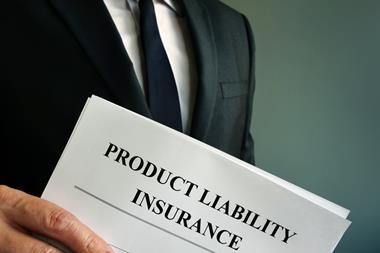David Cowan, a partner in the Brussels office of Beachcroft Wansbroughs, assesses the implication for insurers of the European Commission's Product Liability Green Paper
On July 28 1999, the European Commission released a green paper to consult interested parties on potential revision of the 1985 EU Product Liability Directive. The directive, which went on to the statute books of most EU member states in the early 1990s, seeks to protect victims of damage to health, safety and property caused by defective products.
Key principles of the directive
The directive also enables member states to limit compensation to a minimum of ¤500 (around £285) and a maximum of ¤70m (around £40m).
The green paper, the consultation period for which ended on November 28 1999, throws up a number of important questions as to whether these principles should be revised. The view of the European Insurers Committee (CEA), the body representing the insurance trade associations of 29 European countries, is that any revision is unnecessary at this stage, since it is too early to judge the effectiveness of the directive. Furthermore, there is no evidence to suggest that victims of defective products go uncompensated.
It is impossible to cover all the specific questions raised by the green paper in this article, which will concentrate on two of the most controversial issues – market share liability and compulsory product liability insurance cover.
Market share liability
The US theory of market share liability (MSL) enables damages payments to be shared among all the producers linked to the defective product according to their market share. Its purpose is to alleviate the burden on victims of determining the identity of the producer where the same product is made by several – for example, drugs manufactured under licence by several laboratories.
In 1980, the Supreme Court of California applied MSL in a case relating to the drug diethylstilbestrol (DES). A female hormone used to prevent miscarriages, it was a source of cancer among children of women who had taken it. The Court held that any producer who placed DES on the market was liable to the extent of his market share – thus avoiding any problems in tracing the origin of the product.
In a similar case tried in the Netherlands, however, the Dutch Supreme Court rejected MSL in favour of finding every producer jointly and severally liable. The CEA argues that the Dutch court's judgment lends support to its view that MSL, if introduced in the EU, might compromise product safety – small producers with low market shares would have no incentive to adhere to product safety standards as the largest proportion of liability would fall upon the major market players. In addition, it would complicate risk assessment – insurers would only be able to assess/quantify their exposure to risk once a case had been concluded.
Compulsory cover
The green paper also addresses the crucial issue of whether product liability insurance should be made compulsory for producers; or whether voluntary cross-sectoral agreements between producers and insurers should be encouraged instead (in Sweden and Finland, pharmaceutical manufacturers have agreed to set up a compensation fund for damages caused by medicinal products).
The CEA's view is that the vast majority of producers already purchase cover and that compulsory cover would lead to small producers purchasing excessive cover, while large producers would purchase inadequate cover. The UK Government supports this approach, arguing that product liability insurance cover is a matter for individual businesses to decide in line with other commercial risks.
The way forward
As these two issues alone highlight, any potential revision of the directive could have important implications for the European insurance industry. The Commission is in the process of collating responses to the green paper. At the end of 2000 it is due to submit a report to the European Parliament outlining its proposals, if any, to reform the existing regime. It can only be hoped now that the Commission's proposals provide an appetising recipe for success and not insurance indigestion.
Hosted by comedian and actor Tom Allen, 34 Gold, 23 Silver and 22 Bronze awards were handed out across an amazing 34 categories recognising brilliance and innovation right across the breadth of UK general insurance.







































